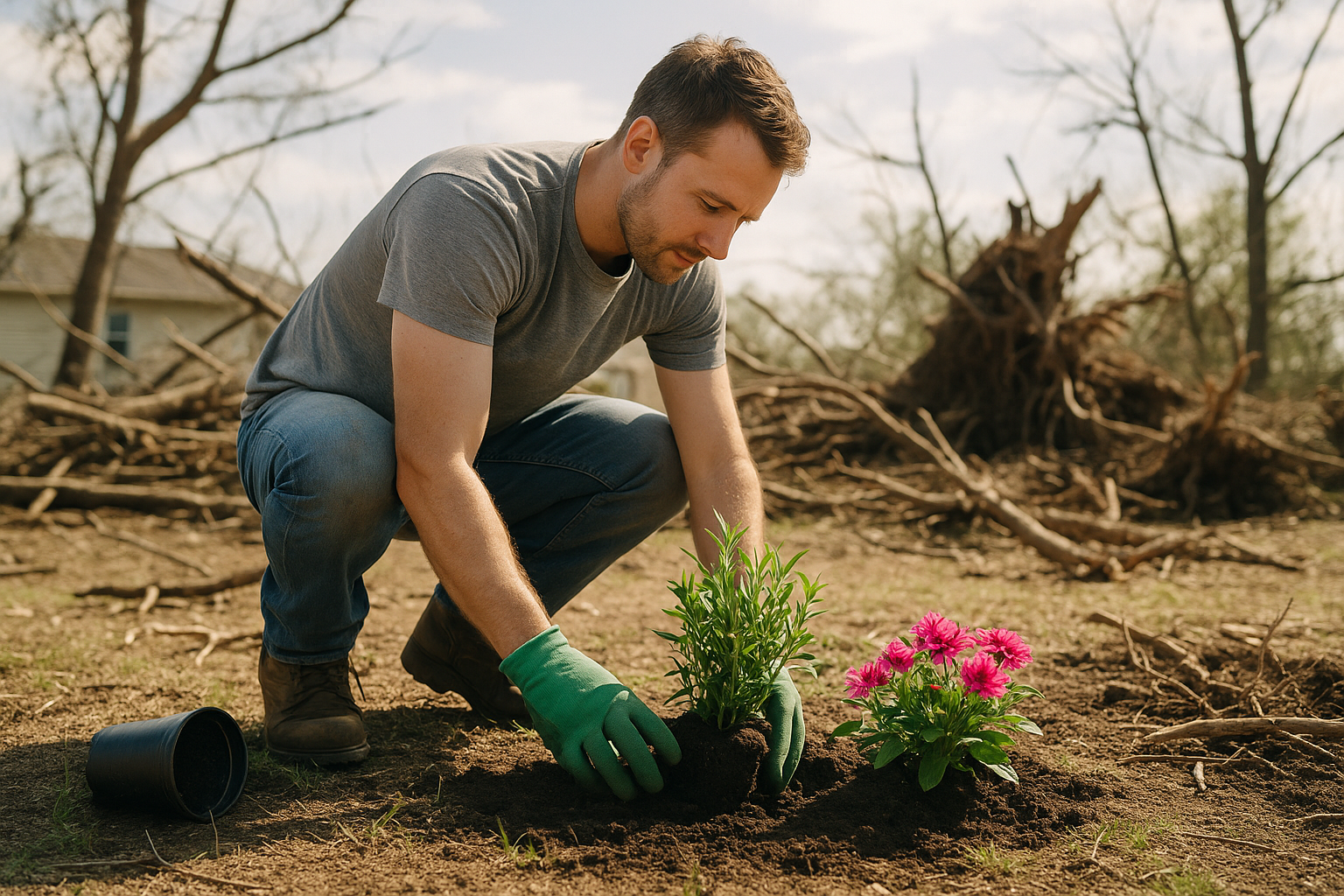Natural disasters leave behind more than physical damage. The emotional toll of seeing a once-thriving yard reduced to debris can feel overwhelming. Recovering green spaces supports personal healing and helps wildlife return. With patience and the right approach, restoration after storms, floods, fires, or freezes can lead to a renewed, resilient environment. This guide offers practical steps, from clearing hazards to selecting the best plants for future challenges, to help any homeowner achieve real garden recovery.
Examining Damage After a Natural Disaster
Storms, fires, and floods disrupt everything in their path. Before any repairs or new plantings, walk through your space and observe. Soil often changes after heavy rain, fire, or standing water. Feel the texture with your hands. Is it compacted or full of ash and sand? Check for layers of silt or evidence of erosion. Using a simple soil test for pH and nutrients gives insights into what your new plantings might need to thrive.
Plants react differently under stress. Leaves may wilt, brown, or drop completely. Roots can suffocate under standing water. Stalks may crack during windstorms. Study each plant up close. Save mature shrubs or trees if their structure appears intact, but remove broken or split sections. Sometimes, what looks unhealthy can recover with a season of growing. Others, however, may never return to full strength and should be replaced to avoid any future hazards.
Man-made elements also require inspection. Fences, patios, or rock paths shift under torrential rain or wildfire. Broken irrigation lines not only waste water but also contribute to further soil instability. Make note of every change, large or small. Early identification reduces surprises later in the restoration process and supports a smooth garden recovery.
Staying Safe During Cleanup
An area hit by disaster hides more dangers than what appears on the surface. Debris sometimes includes hidden nails, glass, or chemicals washed in by floodwaters. Move slowly and deliberately as you remove fallen branches or transport materials away from existing beds. Prioritize removing debris in open areas first, keeping pathways clear for easy access. Avoid lifting anything heavy alone. For large trees leaning at odd angles, rope off around them and work with experienced arborists. Unstable trunks can fall without warning. Certified experts have special tools and knowledge for safe removal. Refer to reliable organizations like Georgia Forestry Commission for additional guidance.
Personal protective gear is well worth the investment. Sturdy boots protect from hidden nails or glass, while thick gloves reduce the risk of splinters and stings. Safety goggles come in handy when dealing with flying debris or when trimming sharp branches. Prevent injuries by working during daylight hours only. If chemicals may have entered your property due to flood or wind, wear a mask while cleaning.
Restoring and Rebuilding Soil Health
Soil forms the backbone of any outdoor sanctuary. Disaster events often deplete vital nutrients or compact the ground, making it harder for roots to penetrate. Nourish soil with organic material. Well-aged compost or manure returns energy and life to tired ground. Topdressing with compost not only aids fertility but also improves structure, allowing air and water to move freely.
Mulching works wonders for exposed ground. A thick layer of organic mulch (like bark or straw) protects tender roots from temperature extremes. Mulch also reduces water loss and stops weed seeds from taking hold, giving recovering plants space to grow. Plant low-growing perennials in areas prone to runoff. Their roots grip soil securely, providing lasting erosion control.
Contaminants may linger after a disaster, especially after flood or fire. This is where your initial soil test proves invaluable. Should results reveal harmful substances or a pH out of the acceptable range, take immediate corrective action. Gypsum helps break up clay-heavy soil. Lime raises pH if things have skewed too acidic, while sulfur brings a high pH back down. Use natural amendments first for long-term health.
Encourage the return of beneficial microbes and earthworms. These small organisms survive best in a covered, nourished environment rich in compost. Their activity aerates soil naturally, improves drainage, and cycles nutrients quickly. Patience pays off. Allow time for these invisible helpers to rebuild your soil from the ground up.
Selecting Plants for Garden Recovery
A thriving yard depends on the right plant choices. Native species offer unmatched advantages. Over generations, they have adapted to local extremes, be it drought, heavy storms, or sudden cold snaps. These plants tolerate unpredictable weather while requiring less water and fewer chemicals. Species like purple coneflower, switchgrass, or wax myrtle hold soil tightly and provide food for native birds and pollinators.
Diversity builds insurance for future events. By mixing evergreen and deciduous shrubs with a mix of annuals and perennials, you reduce the risk of a single pest or disease taking over. A varied garden also supports a higher number of beneficial insects and animals, creating a natural defense against outbreaks. Plant groups at staggered heights, with taller plants at the back and creeping groundcovers in the front. This arrangement maximizes sun exposure and moisture collection for all species involved.
In fire-prone areas, opt for species that contain high moisture in their leaves and resist fast burning. Examples include certain types of sage, succulents, and native bulbs. Water-wise gardens in dry climates benefit from gravel gardens planted with drought-tolerant wildflowers and shrubs. After flooding, avoid water-loving exotics that may take over. Instead, tuck low-growing native grasses along problem spots for stability.
Use new installations as a chance to introduce options that feed local wildlife. Select flowers with nectar for bees and butterflies or berry producers for birds. Over time, your efforts rebuild the ecological web disrupted by disaster and help restore balance.
Building for Future Resilience
Preventing future disaster damage starts with smart design. Proper water management cannot be overstated. Shape beds slightly higher in flood-prone spots. Channel runoff using shallow ditches or swales planted with moisture-loving natives. In regions that see frequent downpours, create rain gardens to slow and absorb excess water. Guide overflow away from structures, choosing gravel-filled trenches if needed. These steps reduce puddling and erosion, making garden recovery easier next time.
For fire recovery, maintain a buffer around all buildings. Remove dry debris regularly, including leaves and overgrown grass. Replace wooden mulch near homes with stone or gravel that will not catch fire. Limit evergreen trees that often act as fuel. Allow for open space between plantings without sacrificing privacy by using staggered shrubs and a mix of heights.
Install drip irrigation for efficient, deep watering. Drip lines reduce evaporation and keep foliage dry, a key factor in preventing disease outbreaks. Set timers for early morning runs, so water soaks the soil before daytime heat. Rain barrels collect roof water for reuse during dry spells. By capturing rain onsite, you reduce runoff and dependence on municipal supplies.
Sustainable choices do not end with installation. Maintain a schedule for soil testing and top-dressing each season. Watch for disease or insect outbreaks and respond quickly with natural solutions. At every step, choose methods and materials that strengthen your garden against nature’s next test.
Wildlife Returns with Careful Recovery
Birds, bees, butterflies, and small mammals depend on healthy environments for survival. Many are among the first to vanish after a major storm or fire. Bringing them back starts with thoughtful planting. Native trees and shrubs provide dense shelter and reliable sources of food. Swaying grasses and blooming flowers serve pollinators and insects important to the local food chain.
Water sources become critical, especially after drought or fire. Install shallow birdbaths in shaded corners, keeping them clean and refilled. Rocks piled loosely create homes for lizards or insects, while brush piles in quiet corners offer safe hideouts. Swaths of unmown grass allow ground-nesting birds to return.
Balance is key. Avoid using synthetic pesticides and fertilizers that threaten beneficial insects or leach into nearby waterways during rains. Rely on physical barriers or release natural predators (like ladybugs) to control pests. As native plants fill in, their flowers and seeds provide a steady food supply, luring wildlife back to your property season after season.
When to Seek Professional Restoration Help
Massive disasters may leave owners feeling lost. Not every damage can be repaired alone. Engage with reputable restoration companies who have handled disaster garden restoration for years. These professionals bring not just equipment but also the right experience to spot risks, address root problems, and restore order quickly. They recommend proven soil amendments, find hidden structural issues, and rebuild gardens in a way that minimizes disruption to recovering wildlife and people alike. For extensive debris, large fallen trees, or deeply damaged irrigation, their help speeds up recovery while lowering physical risk.
Look for companies with strong reviews and well-documented experience. Ask about their process, from site evaluation to recommendations for plants and structures built to withstand local threats. Trustworthy teams work closely with you to restore both beauty and function. To learn more, visit the professionals at Restoration Masters for disaster-specific solutions.
Encouraging Patience and Continued Growth
Healing an outdoor space does not happen overnight. The seasons bring correction and renewal at their own pace. Some years, recovery happens quickly, with new shoots pushing through charred ground or debris-laden soil. Other seasons, growth comes slowly, especially as invisible life underground rebuilds. Celebrate each milestone: the return of the first flower, the sound of songbirds, or a thick carpet of fresh green.
Tend the soil often to support strong root development. Prune shrubs lightly to encourage new growth and check for damage after heavy winds or rains. Add compost or mulch as needed but try to disturb soil as little as possible to protect the developing ecosystem. With time, your yard recovers strength and beauty, offering both a place of rest and an anchor for local wildlife for years to come.
Conclusion: Strength Grows from Recovery
Recovering outdoor spaces after disaster calls for patience, groundwork, and steady vision. Start with safety, then restore soil health and carefully select native, resilient plant species. Plan spaces that withstand floods and fire, while providing food and shelter for returning wildlife. Success depends on both persistence and the ability to adapt as new challenges arise. Whether working alone or with trusted professionals, the result is a vibrant, valuable haven ready to survive whatever the next season brings. Garden recovery becomes more than repair, it becomes a foundation for future resilience and natural beauty.


